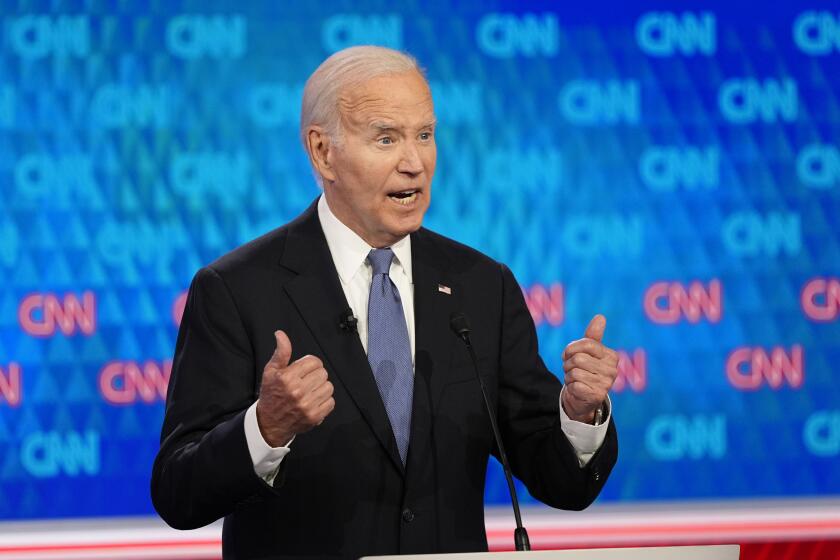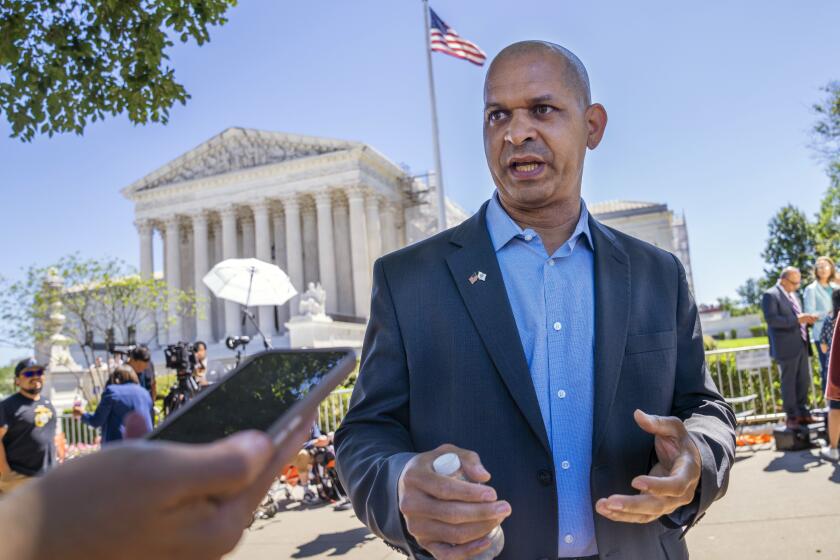Virginia and New Jersey swung right, California didn’t. How come?

The past two months have seen elections for governors in three big states. In California, the results showed virtually no change from the state’s previous partisan divide; in Virginia and New Jersey, the electorate swung to the right by more than 10 points.
How come?
California often gets left out of national political analyses because it’s so heavily Democratic. That’s a mistake. The fact that Democrats start at a higher level doesn’t explain why the state’s partisan divide stayed the same this fall while the other two states shifted.
Thinking through what caused the three elections to diverge highlights a couple of facts about current politics: One offers a warning to Democrats, the other a caution to Republicans.
Get our L.A. Times Politics newsletter
The latest news, analysis and insights from our politics team.
You may occasionally receive promotional content from the Los Angeles Times.
Biden’s slide, Trump’s unpopularity
In Virginia, with some late-arriving ballots still outstanding, Republican Glenn Youngkin’s victory by about 2.5 percentage points over the Democrat, former Gov. Terry McAuliffe, represents a roughly 11 point swing from the last election for governor, in 2017.
In New Jersey, with more than 95% of the vote counted, Democratic Gov. Phil Murphy was winning by fewer than 60,000 votes out of roughly 2.5 million cast. His margin of nearly 2.5 percentage points over Republican Jack Ciattarelli also represents about an 11 point swing from four years ago.
By contrast, Gov. Gavin Newsom‘s 62%-38% victory in September’s recall election almost precisely matched his sweeping victory margin in 2018.
Why the big difference?
First, let’s dispose of a factor that is much talked about but can’t really be blamed for Democrats’ current problems — turnout.
In 2010, and again in 2014, Democrats did suffer a major turnout problem which led to massive losses. The idea that their base doesn’t show up for non-presidential elections has become fixed in the minds of many Democrats.
It’s an explanation that syncs up well with the party’s recurring internal debates in which progressives charge the establishment with pushing overly cautious candidates who, they say, can’t mobilize young voters and people of color — candidates like McAuliffe, who has been an establishment figure since Bill Clinton‘s presidency.
But this wasn’t a low turnout election: McAuliffe won about 200,000 more votes than fellow Democrat, Gov. Ralph Northam, did four years ago in an election that, at the time, set turnout records. The problem for Democrats was that Youngkin won about 550,000 more votes than the GOP’s 2017 candidate, Ed Gillespie.
We may not see another truly low turnout election for years, said Michael McDonald, a University of Florida political scientist and a leading expert on the topic.
“We’ve now had the highest-turnout congressional election since 1914,” he said, referring to the 2018 midterm contest, and last year, “the highest presidential turnout since 1900.”
After 2020, he said, he wondered whether voters would remain engaged once former President Trump was no longer on the ballot.
“Now we know the answer,” he said. “Trump may have been the catalyst” for higher voter engagement — generating intense feelings pro and con — “but the fire is still raging.”
What the Virginia election proved was that high turnout doesn’t automatically favor Democrats, as activists in both parties almost instinctively believe.
Democrats also suffered from voters switching sides. Analysts won’t be able to estimate how many for months, but it’s clear that the number was significant, and the same is likely true in New Jersey.
Why the switches? In part, McAuliffe ran a lackluster campaign that didn’t tell voters much about what he wanted to do in office, and Youngkin skillfully exploited parental anxieties about schools, a significant chunk of which have a racist undertone. In New Jersey, Murphy’s advocacy of some of the toughest COVID-19 restrictions in the country rankled many voters.
But those factors can’t explain the pattern of all three states.
Instead, look at the overall national political environment.
On Aug. 16, when early voting began in California, President Biden still held a 50% approval rating in the average of polls maintained by the fivethirtyeight.com website. Newsom ran in a political environment that tilted only slightly against his party.
By election day this week, Biden’s approval had tumbled to 43%, with 51% disapproving. That makes Biden the most unpopular president at this point in his tenure in nearly 40 years with the singular exception of his predecessor, whose standing with the public at this point in his term had fallen to 38%.
In a highly polarized political environment, in which nearly every partisan race becomes nationalized, a candidate simply can’t swim against that sort of tide.
Why has Biden’s standing dropped so sharply? Again, there’s more than one reason, but two jump out from the polling: Biden’s slide began when the COVID-19 pandemic turned worse this summer, and it accelerated this fall in tandem with concerns over inflation.
In Wisconsin, for example, a Marquette University poll released on Wednesday showed 64% of voters were “very concerned” about inflation. That was up from 49% less than three months ago.
On the national level, Gallup’s polling has shown a sharp decline this fall in confidence about the economy, with fears of inflation ticking upward.
In the aftermath of Tuesday’s voting, Democrats have spent a lot of time arguing over whether the results showed that they should accelerate or slow down their push to pass Biden’s sweeping bill to expand social programs and battle climate change.
Undoubtedly, the months of negotiations over Biden’s program have contributed to a sense among voters that the president isn’t getting things done. But average voters just don’t pay as much attention as lawmakers, lobbyists and journalists do to the fate of legislation — especially not to bills whose impact won’t be felt for months or years.
“There are people who think Biden and the Democrats should have done much more, and others who think they’ve gone too far,” said Marquette political scientist Julia Azari. “Public opinion is just always going to be mixed.”
Beyond that, any legislative promise runs up against deeply engrained doubts about the political system.
“People are discontented with the way things work, but they’re also skeptical of change,” Azari said. “Americans have trouble believing that any change won’t screw them over.”
For now, the election results point to something basic: For Democrats, getting back in voters’ good graces starts with convincing them the pandemic is under control and inflation won’t eat away at family budgets.
But Republicans shouldn’t be too quick to count their winnings. The comparison among the three states points to another major factor — the nature of the GOP candidate.
“Until Larry Elder emerged” as the face of the recall, Newsom faced significant trouble, said Sacramento-based Republican strategist Rob Stutzman. “Elder is no Youngkin.”
“Youngkin threaded the needle of being a post-Trump candidate” in a way that Elder, the Los Angeles-based talk-radio host who dominated the Republican field in the recall, never even tried, Stutzman said.
The problem for Republicans is that a powerful force in their party rejects the very idea of post-Trump candidates — the former president, himself.
Trump remained relatively disciplined during the Virginia race, only occasionally inserting himself in ways that created trouble for Youngkin. Few Republicans expect he’ll be so restrained through the midterm campaign, let alone the next presidential election.
Yet as the recall results indicated, nominating a candidate who too closely resembles Trump allows Democrats to hold onto swing voters like the ones who deserted them this week.
The Marquette poll, for example, showed only 43% of voters in Wisconsin, a crucial swing state, approved of Biden’s performance in office. It also showed they still preferred Biden to Trump in a hypothetical 2024 rematch, 45%-41%.
Tuesday “was a bad night for Joe Biden,” said Stutzman. “It was also a bad night for Donald Trump.”

Our daily news podcast
If you’re a fan of this newsletter, you’ll love our daily podcast “The Times,” hosted every weekday by columnist Gustavo Arellano, along with reporters from across our newsroom. Go beyond the headlines. Download and listen on our App, subscribe on Apple Podcasts and follow on Spotify.
The latest from Washington
Biden touched down in Washington in the wee hours of Wednesday morning, returning from a European trip that included a summit of major economic powers and a global conference on climate change. But as Chris Megerian, Erin Logan and Melanie Mason reported, the fate of his legislative package hovered constantly in the background.
On Thursday, the House moved toward votes on both the social spending package, which would devote about $1.75 trillion over the next 10 years to expanding social programs and fighting climate change, and a separate $1.2-trillion bipartisan bill on infrastructure. House leaders expect to vote as early as Friday on both bills.
One of the final points under debate among Democrats was how to restore the federal income tax deduction for state and local taxes, which was capped at $10,000 a year by Republicans in their 2017 tax bill. Raising that cap has been a key demand for Democrats who represent areas with high taxes and housing prices, especially in California and the New York metropolitan region, as Jennifer Haberkorn reported.
As debate continued on the spending bills, Senate Democrats failed to break a Republican filibuster that blocked debate on a key voting rights bill, Logan reported. Sen. Lisa Murkowski of Alaska was the only Republican in favor of moving ahead to a vote on the John Lewis Voting Rights Advancement Act. Under current rules, 60 senators would have been needed to end the filibuster.
The bill would restore the rule requiring states to get advance approval from the Justice Department before making significant changes in their voting systems. In 2013, the Supreme Court ended that requirement, known as pre-clearance, and voting restrictions have proliferated since.
After the 2020 election, Smartmatic, a company that makes voting software, became a major target of false claims by Trump supporters, who said its programs had allowed Democrats to alter voting returns in key states. The company’s software isn’t used in any of the states in question. In February, the firm sued Fox News and several lawyers close to Trump for defamation. On Wednesday, Stephen Battaglio reported, the company expanded its suit to cover OAN and Newsmax, two other networks that featured the false claims.
As David Savage reported, the high court on Wednesday heard another of the major cases on this year’s docket, this one involving gun laws. The court’s conservative justices seemed likely to expand rights for gun owners, sounding skeptical about a New York law, similar to statutes in California and some other states, that restricts people’s ability to carry guns in public.
Enjoying this newsletter? Consider subscribing to the Los Angeles Times
Your support helps us deliver the news that matters most. Become a subscriber.
United States of California

In the latest in his continuing series on the impact California has had on public policy in the U.S., Evan Halper looks at legal weed. The battle to legalize marijuana got its first major victory 25 years ago with the passage of California’s Compassionate Use Act, which made medical marijuana legal.
Today, 36 states have legalized medical pot, and 20 allow recreational use, but the federal government still lists marijuana as a highly dangerous drug, making research into its use arduous. After years of debate, however, the Biden administration has started to loosen the rules on research. Two new centers, one in Phoenix, the other near Monterey, have gotten licenses to grow marijuana for federally sanctioned research.
The latest from California
Los Angeles has made a major change in how it deals with homelessness, putting a priority on clearing unsightly street encampments even when there’s not enough permanent housing for the people being moved, Ben Oreskes and Doug Smith reported. Advocates for the homeless say the new policy risks elevating politics over need, focusing on clearing street encampments that have become liabilities to members of the City Council.
As the drawing of new district lines in California moves forward, many Black voters are growing concerned that the process could result in cutting Black representation in Congress, Seema Mehta reported.
The Los Angeles congressional delegation currently has two Black members, Reps. Maxine Waters and Karen Bass. But both of their districts are under-populated compared with other parts of the region, and the state’s independent Citizens Redistricting Commission has considered combining large parts of the two districts into one.
Nolan McCaskill reported on another aspect of Black representation: 20 years have passed since a Black man represented California in Congress. No Black man has won election since the late Rep. Julian Dixon died of a heart attack just a month after winning reelection in 2000. Advocates say that Democratic officials have failed to make advancing Black men a priority.
Sign up for our California Politics newsletter to get the best of The Times’ state politics reporting.
Stay in touch
Keep up with breaking news on our Politics page. And are you following us on Twitter at @latimespolitics?
Did someone forward you this? Sign up here to get Essential Politics in your inbox.
Until next time, send your comments, suggestions and news tips to politics@latimes.com.
Get the L.A. Times Politics newsletter
Deeply reported insights into legislation, politics and policy from Sacramento, Washington and beyond. In your inbox three times per week.
You may occasionally receive promotional content from the Los Angeles Times.




